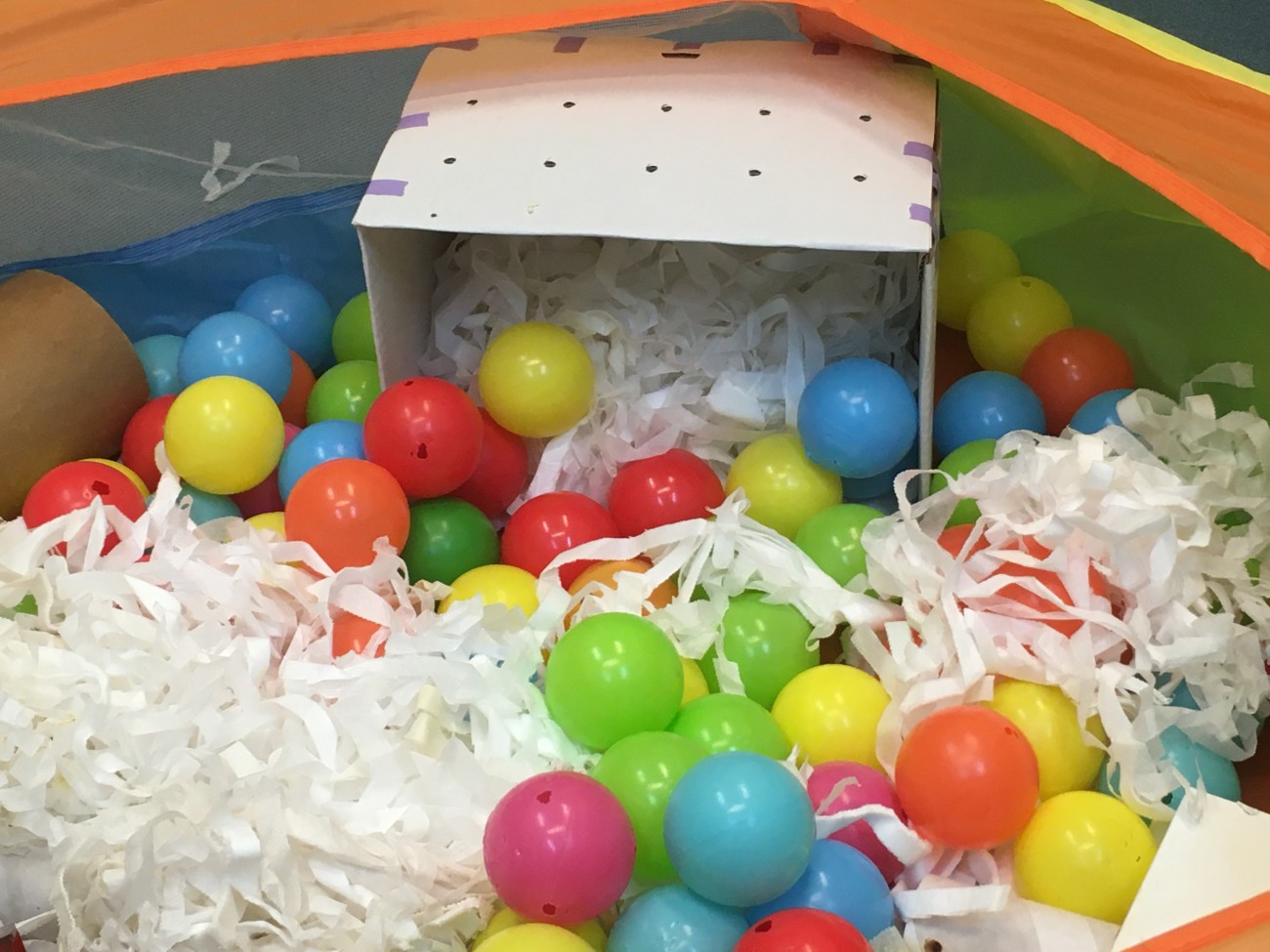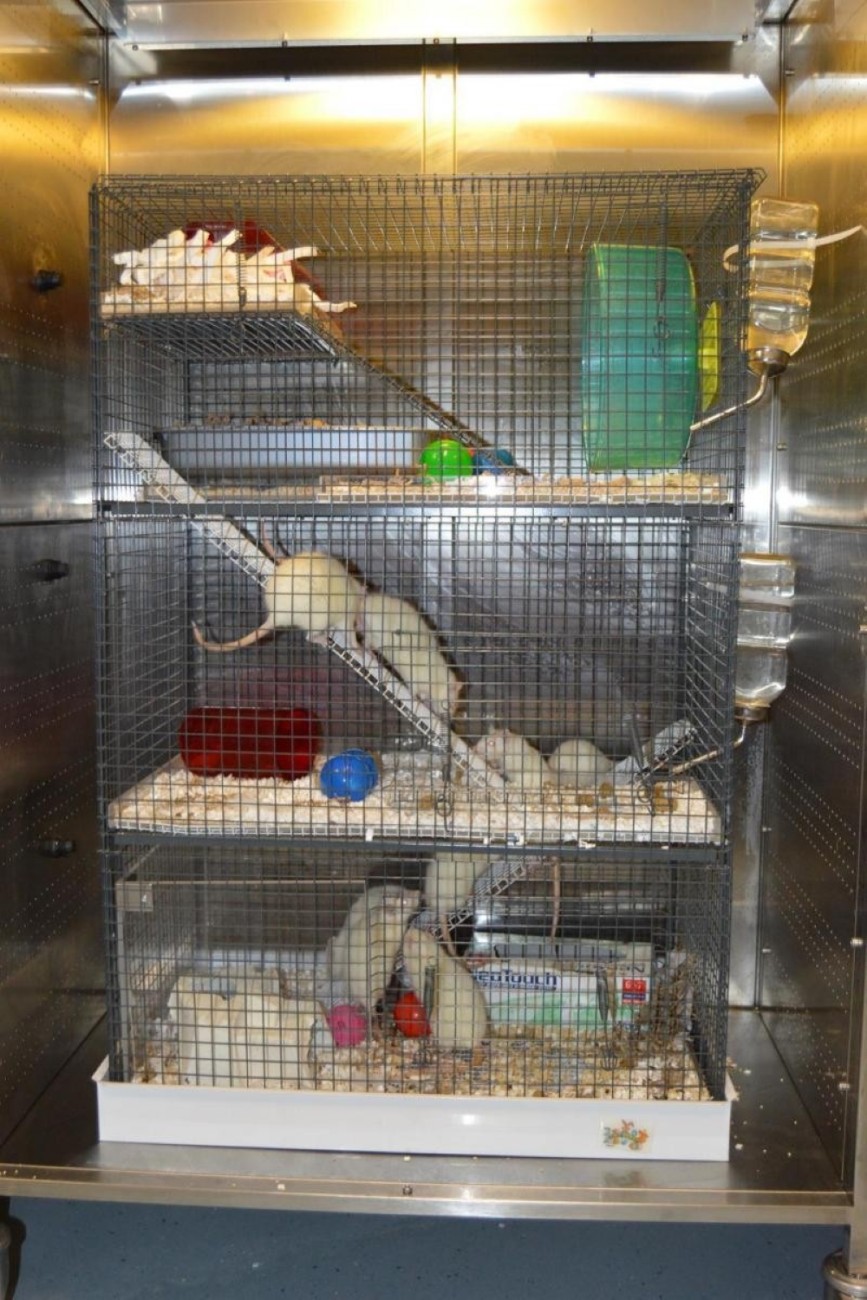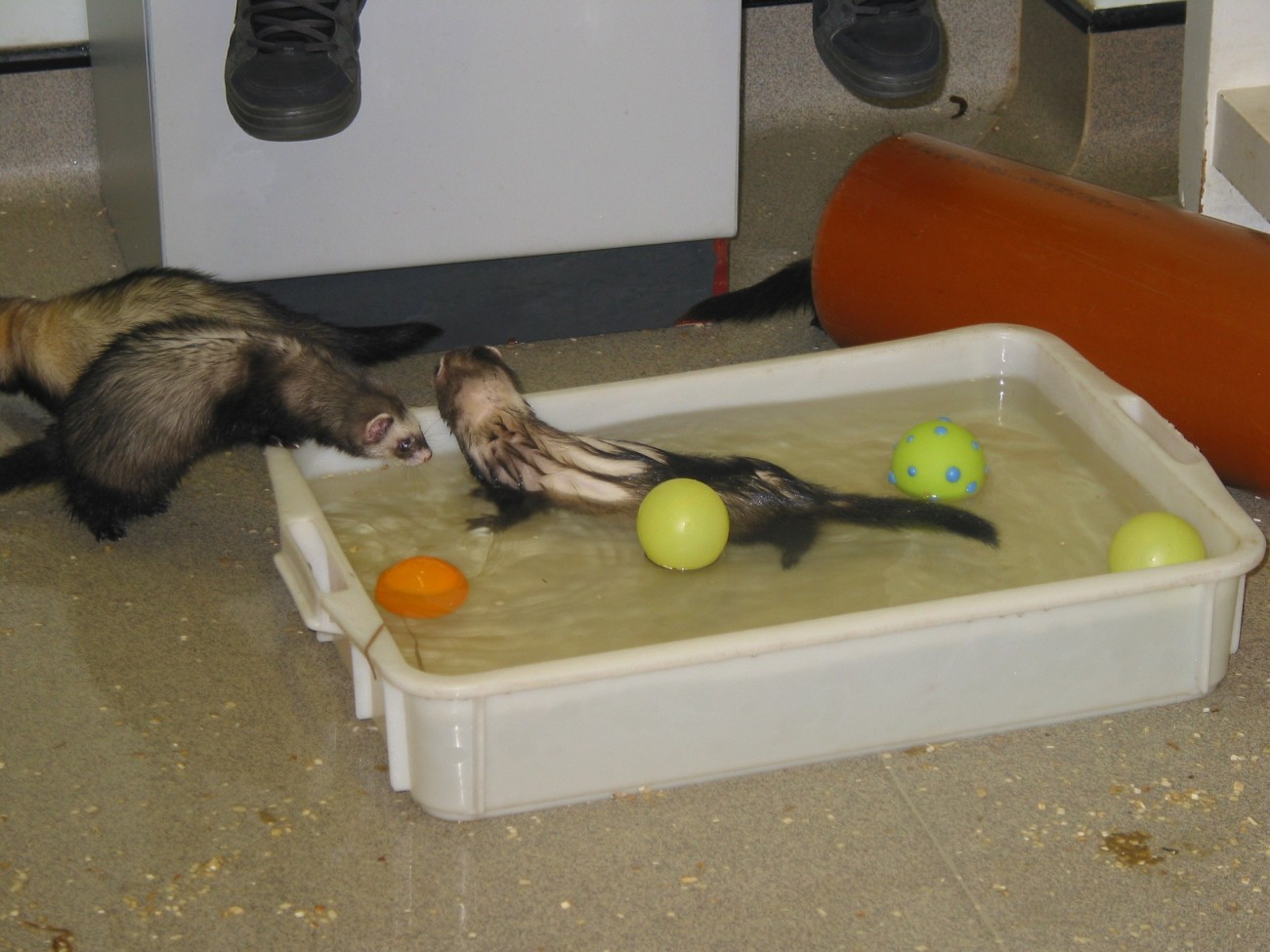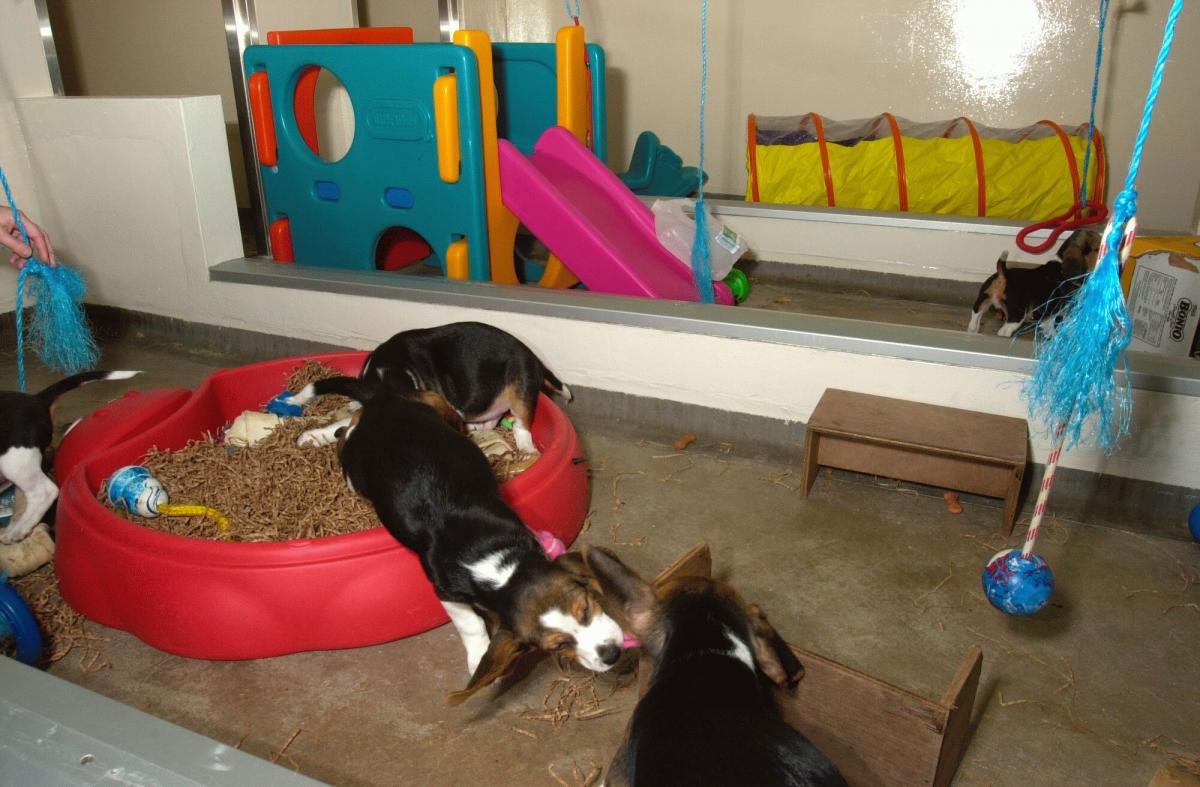Rat playpens
The positive impact playpens have on laboratory rat welfare, and guidance on how to set one up in your institution.
On this page
Introduction
A playpen, or playroom, is a designated enriched space that is usually provided as an addition to the standard housing of animals. Access to a playpen has a positive impact on research animal health and wellbeing, which can consequently benefit animal technicians and researchers. This resource outlines these benefits and provides practical advice, focusing on playpens for rats. Some of the general principles and literature may also be relevant to other species.
The benefits of playpens
Playpens provide captive animals with additional space and the chance to interact with a wider range of enrichment than what can usually be provided within standard caging. Playpens create opportunities to:
- Improve overall wellbeing and scientific outcomes
- Provide additional socialisation
- Reduce handling-associated stress
- Habituate animals to new objects
- Improve job satisfaction
- Recycle old equipment
Improve overall wellbeing and scientific outcomes
Facilitating animals to perform natural, healthy behaviours is beneficial to their physiological and psychological wellbeing. Within a research environment, traditional housing often restrict what behaviours can be performed.
Small cages with only basic enrichment limit the ability of animals to exercise and engage with their environment. When behaviour is constrained in this way animals can become chronically unfit, overweight and understimulated, resulting in abnormal physiology and behaviour. Ultimately, data obtained from these animals could lead to unreliable conclusions, regardless of the area of study [1,2].
Access to a playpen provides a solution to the welfare challenges associated with research-animal housing. Rats in enriched environments display a wider range of behaviours than is possible in traditional caging, including vertical stretching, hopping, burrowing and climbing [3,4]. In addition to opportunities for exercise and wider behavioural expression, welfare benefits are also indicated by the preference of rats for more complex, enriched environments [see 5 for an overview].
A recent study has shown that rats produced a higher number of 50 kHz vocalisations during sessions in a ball pit and playpen compared with control conditions [6]; these 50 kHz calls are within a range repeatedly shown to be associated with positive affect (mood) and welfare [7, 8]. Furthermore, playpen time mitigated the negative effects of an aversive drug treatment in these rats, suggesting that the use of playpens could reduce the negative impacts of some aversive procedures.
Provide additional socialisation
Social interactions are crucial for the development and wellbeing of social species, such as rats [9].
However, it is not always possible to house research animals in their preferred group size, and in exceptional circumstances it may be necessary to singly house rats during a study, or for breeding purposes. A lack of social interaction can have a major impact on rat welfare and there is no true substitute for being able to engage with other rats.
The social mixing of rats within a playpen provides an opportunity for them to interact in a positive way. Even if the rats do not directly interact with each other (e.g. by playing or huddling), they will still be indirectly engaging by smelling the scents and hearing the vocalisations of other animals.
Kate Shenton (AstraZeneca) spoke about her experiences providing rats with additional opportunities for exercise and socialisation at IAT Congress 2017: playtime for rats.
Carina Christoffersen, an Animal Welfare Technician at Ellegaard Göttingen Minipigs, Denmark, noted that access to a playroom facilitated the formation of stable social groups in young pigs. Carina was featured as a 3Rs Champion in Tech3Rs, our newsletter for animal technicians.
Reduce handling-associated stress
Handling an uncooperative animal can be stressful, and even dangerous, for both the animal and the handler. There can be additional stress for the animal if they associate being handled with negative experiences (e.g. aversive scientific procedures).
Playpens provide an opportunity for regular positive human-rat interactions, which makes rats calmer and easier to handle [5] and can even lead to rats actively seeking out interactions with humans. Positive human-rat interactions are important for both animal and staff wellbeing [5,10]
Ms Marie Eriksson presented training techniques used at her facility for less stressed laboratory rodents at the 2019 NC3Rs/IAT Animal Technicians’ Symposium.
Rat tickling is another way to promote positive human-animal interactions. Rat tickling can take place in the home cage or be incorporated into playpen sessions.
Habituate animals to new objects
Playpens can be used to introduce animals to novel equipment, such as transport containers or scientific tools, before they are exposed to them in day-to-day use.
Novel objects are placed into the playpen, along with a range of enrichment items, allowing the rats to engage with the objects on their own terms. Rats are motivated to explore and spending time in enriched spaces can accelerate their habituation to novelty [11]. Treats can be placed in or around the equipment to encourage the animals to investigate and to build a positive association.

Improve job satisfaction for animal technicians
There can be a cost of caring for research animals, which can lead to laboratory animal professionals experiencing compassion fatigue [10]. Being able to provide good environmental enrichment is a factor related to improved job satisfaction for animal technicians [10].
Playpens add an enjoyable aspect to the role of animal technicians, allowing them to express creativity, take ownership of an animal welfare project and experience positive human-animal interaction.
The NA3RsC has created a resource for research animal professionals on compassion fatigue.
Dr Megan LaFollette discussed compassion fatigue research and improving staff wellbeing in an animal research setting and how it can affect the mental wellbeing of animal care staff in this joint NC3Rs and NA3RsC webinar.
Recycle old equipment
Animal facilities can generate a lot of waste and budgets can be tight. Playpens provide an opportunity to recycle items that may otherwise be discarded. For example, an old rabbit pen with some damage is not suitable for use as a permanent enclosure, but it could be repurposed as a rat playpen. Packaging materials, such as old glove boxes, can be an appealing place for rats for to huddle, or they may just enjoy shredding the cardboard.
It is important to ensure that repurposed materials will be safe for the rats, but it is possible to create a playpen using entirely recycled items.
Setting up a rat playpen
Key features of rat playpens
- Larger than standard housing; adequate space to create a complex environment.
- Vertical height of >30 cm; enough room to rear to full height.
- A range of enrichment items not found within the home cage.
- Social enrichment i.e., the opportunity to engage with other rats.
Tips for setting up a rat playpen
- Discuss your plans with colleagues. You may wish to consider the barriers to adoption and ways to overcome these that were outlined in this IAT Congress workshop summary.
- Source an enclosure to use as a playpen. Rat playpens can be built by repurposing old cages, for example, Xenopus tanks, rabbit cages, diet bins and marmoset cages. The playpen needs to have vertical and horizontal space to allow the rats to run, hop, rear to their full height and engage in social behaviours.
- Source appropriate items for your playpen, ensuring that the pen itself and the enrichment items are safe and clean. Consult your NACWO or veterinarian if you have any doubts about suitability.
- To keep down costs you can furnish the playpen with enrichment items from within the facility, for example empty glove boxes, paper towel rolls, bins filled with nesting material, dishes of shallow water.
- Your aim is to create a complex environment that engages the senses and facilitates a range of natural, healthy behaviours. Enrichment that meets these criteria includes treats scattered within substrate, scented gnaw sticks, soil for burrowing and ladders for climbing. Consider creating your own puzzle feeders to cognitively engage the rats.
- Consider the biosecurity of your unit and what is possible within these constraints. This will determine the groupings of rats within a playpen session and the cleaning schedule.
- Monitor playpen use to ensure safety and suitability. You may wish to carry out a small study to see whether access to a playpen improves welfare.
For more practical advice on setting up rat playpens see:
Kate Shenton’s (AstraZeneca) practical strategies for providing rats with a complex environment.
The NC3Rs webinar: Rat playpens for improved welfare.

Rat playpen FAQs
No, not necessarily. Some facilities will provide money to set up playpens, especially if a pilot study has demonstrated clear benefits to animal welfare, however playpens do not have to cost anything. Playpens can be created using items that are already available within an animal facility. Items can be repurposed and recycled, and in some cases free samples can be obtained from laboratory equipment suppliers. It is not necessary to keep obtaining new enrichment items; the same items can be provided in different combinations and rearranged in different ways to maintain novelty.
Time will be required to set up the playpen and to initially monitor the animals while they use it. If the playpen is deemed to be safe and secure, animals can be left alone for their playpen session.
How a playpen and socialisation rota fits into the schedule is flexible and depends on the facility and the individuals involved. Providing playpen access does not need to be time consuming and if the rats begin to seek out human interaction as a result it can lead to time saved during transport, health checks and procedures. Providing playpen access can be enjoyable and rewarding and so animal technicians are often enthusiastic about incorporating it into their schedule.
If time constraints are a concern, then a pilot study could be performed to assess the ease with which rats are handled compared to standard conditions and the impact on the time and frequency of cage cleaning.
In general, spot cleaning for faecal matter can be done daily, with full cleans between different groups of animals (e.g. those used by different personal license holders). However, it is important to look at the biosecurity requirements of the unit which will determine the level of cleaning required between playpen sessions.
The time required to clean depends on the animal group size, playpen size and the kind of enrichment items within the playpen. If the enrichment items are destructible (e.g. cardboard tubes and boxes) these can be thrown away, which is likely to save time over disinfecting objects. It is possible to disinfect and sterilise a range of enrichment, for example, soil can be autoclaved and provided for rats to burrow into.
If this is something of concern a pilot study can be carried out using animals that are not currently under study to investigate the effects of playpen time on scientific outcomes. Consider what data would be valuable to collect to inform decisions regarding scientific endpoints and welfare impacts. For example, some welfare indicators could include stress hormone levels, bodyweight, and ultrasonic vocalisations. The use of playpens may offer an opportunity to observe more subtle experimental effects in these animals compared to animals solely housed in standard caging.
Playpens will be unsuitable for disease models where it is necessary to induce a negative emotional state (e.g. models of stress, anxiety, depression or chronic pain) as the positive effect of playpen time on welfare could interfere with the outcomes of interest [6].
If playpens are going to be introduced, it is advisable to implement this change at the start of a new study rather than during ongoing research.
The animal technicians we have spoken to have not observed aggression between rats in playpens, and other anecdotal evidence suggests that the rats engage with the stimulating environment rather than in agonistic behaviour [5]. However, this does not mean that aggression could not occur.
Aggression should be monitored for, especially when the rats are getting used to the playpen. It is also very important to be vigilant for aggression if rats are mixed with individuals that they are not usually housed with. Enough enrichment should be provided for all animals, with plenty of places for the rats to retreat and hide if they do not want to engage with other rats.
Playpens provide an opportunity for rats to display behaviours that they may otherwise not be able to perform at all, and to increase their overall levels of exercise [4, 5]. For these reasons, regular access to a playpen is thought to improve animal welfare even when the animals spend most of their time in standard laboratory housing.
The animal technicians and researchers we have spoken to have not observed any negative impacts on welfare when rats are returned to their home cages. Indeed, indicators of improved welfare have been observed such as reduced muscle wastage and porphyrin staining, and calmer behaviour that improved ease of handling [5]. Other anecdotal reports state that upon return to home cage, immediately following a playpen session, animals will go to sleep. This suggests that the animals are tired after exercise rather than agitated by removal from the enriched environment.
If this is a concern, a pilot study could be undertaken to assess home-cage behaviour following playpen sessions and the longer-term effects of playpen access.
Disruptions in routine can have a negative impact on animal welfare, and if rats expect a positive experience to occur and it doesn’t, this can lead to ‘disappointment’. We have heard anecdotal reports that when rats become used to regular playpen access and this is suddenly withheld, for example over the holidays, they can become agitated.
This is not a reason to avoid providing rats with a playpen, but we would recommend providing short-term alternatives while playpen sessions are temporarily on hold. For example, rotating in-cage enrichment and scattering treats within the home cage is less time consuming than transferring rats to a playpen, but could still provide them with some variety within their environment. Providing environmental enrichment within the home cage of rats is important for their welfare [12], and access to a playpen should supplement, rather than substitute, this.
When you collect rats from floor-based pens consider how you appear to the animals when you are leaning down from your full height. Rats are fearful of predation from above [13,14] and could mistake humans looming over them for something that intends to harm them. This could result in the rats freezing, hiding or even behaving aggressively towards the handler (defensive aggression) or group mates (redirected aggression).
We recommend calmly speaking to the rats as you come down to their level and making slower-than-usual movements. Consider kneeling before you attempt to pick up the rats and, if possible, encourage them to approach you with treats. It is likely that the rats will become used to the routine of being collected, and rewarding the rats with treats should help speed up this process.
Absolutely! The specific details will vary between species but the general principle of providing access to a larger and more complex environment remains the same. We are aware of playpens or playrooms that have been set up for rabbits, gerbils, dogs, pigs and non-human primates. There is also evidence that mice find playpen access rewarding [15]. A good first step is to carry out a literature search on your species of interest to see what is known about playpens, and enrichment in general, for these animals [16].


Playpens for rats webinar
Dr Jessica Eddy of the NC3Rs presents an overview of playpens and tips for setting them up, and Kirsty Watson, a Senior Animal Technician, outlines how rat playpens were introduced at the Institute of Ophthalmology at University College London and the positive results staff saw.
Resources
- Makowska IJ (2020). The Rat. In: Animal-centric Care and Management, 1st edition. CRC Press.
- Makowska IJ and Weary DM (2019). A good life for laboratory rodents? ILAR journal 60(3): 373-388. doi: 10.1093/ilar/ilaa001
- Kate Shenton’s (AstraZeneca) presentation slides on practical strategies for providing rats with a complex environment.
- Dr Joanna Makowska’s poster on the importance of burrowing, climbing and standing upright for laboratory rats.
- Dr Joanna Makowska’s presentation slides on how rat behaviour and welfare is impacted by conventional research housing and how to overcome these issues using enrichment and playpens.
References
- Poole T (1997). Happy animals make good science. Laboratory Animals 31, 116-124. doi: 10.1258/002367797780600198
- Martin B et al. (2010). "Control" laboratory rodents are metabolically morbid: Why it matters. PNAS 107 (14):6127-6133. doi: 10.1073/pnas.0912955107
- Berdoy M (2002) The Laboratory Rat: A Natural History. Film. 27 minutes. The film can be viewed at www.youtube.com.
- Makowska IJ and Weary DM (2016). The importance of burrowing, climbing and standing upright for laboratory rats. Royal Society Open Science 3: 160136. doi: 10.1098/rsos.160136
- Makowska IJ and Weary DM (2019). A good life for laboratory rodents?. ILAR journal 60(3): 373-388. doi: 10.1093/ilar/ilaa001
- Hinchcliffe JK et al. (2021). The use of ball pits and playpens in laboratory Lister Hooded male rats induces ultrasonic vocalisations indicating a more positive affective state and can reduce the welfare impacts of aversive procedures. Laboratory Animals January 2022. doi: 10.1177/00236772211065920
- Burke CJ et al. (2017) Specific 50-kHz vocalizations are tightly linked to particular types of behavior in juvenile rats anticipating play. PloS One 12(5). doi: 10.1371/0175841
- Hinchcliffe JK et al. (2020). Rat 50 kHz calls reflect graded tickling-induced positive emotion. Current Biology 30(18). doi: 10.1016/j.cub.2020.08.038
- Berdoy M and Drickamer LL (2007). Comparative Social Organisation and Life History of Rattus and Mus, pp 380-392. In: Rodent Societies: An ecological and evolutionary perspective (Eds. Wolff JO and Sherman PW). 1st edition. Univeristy of Chigago Press.
- LaFollette MR et al. (2020). Laboratory animal welfare meets human welfare: a cross-sectional study of professional quality of life, including compassion fatigue in laboratory animal personnel. Frontiers in veterinary science 7, 114. doi: 10.3389/fvets.2020.00114
- Modlinska K et al. (2019). The impact of changeability of enriched environment on exploration in rats. Behavioural processes 164: 78-85. doi: 10.1016/j.beproc.2019.04.015
- Brydges NM et al. (2011). Environmental enrichment induces optimistic cognitive bias in rats. Animal Behaviour 81(1): 169-175. doi: 10.1016/j.anbehav.2010.09.030
- Wallace DJ et al. (2013). Rats maintain an overhead binocular field at the expense of constant fusion. Nature 498(7452): 65-69. doi: 10.1038/nature12153
- Farnworth B et al. (2020). Antipredator responses of ship rats to visual stimuli: combining unimodal predation cues generates risk avoidance. Animal Behaviour 168, 149-157. doi: 10.1016/j.anbehav.2020.08.007
- Ratuski AS et al. (2021). Using approach latency and anticipatory behaviour to assess whether voluntary playpen access is rewarding to laboratory mice. Scientific reports 11(1): 1-13. doi: /10.1038/s41598-021-98356-3
- Pritchett-Corning KR (2019). Environmental complexity and research outcomes. ILAR journal, 60(2): 239-251. doi: 10.1093/ilar/ilaa007
